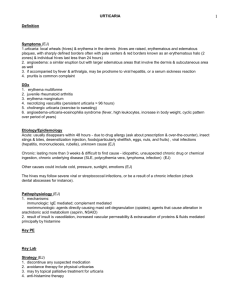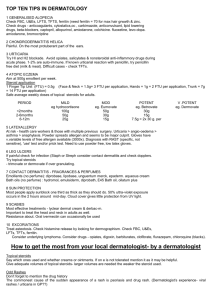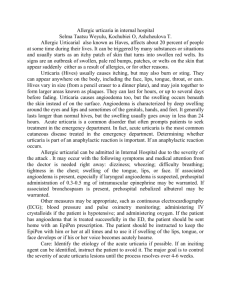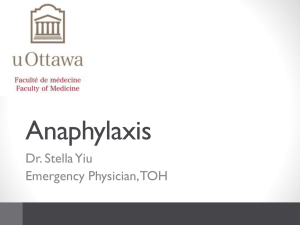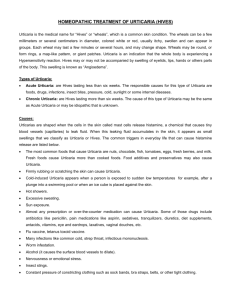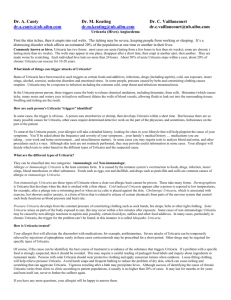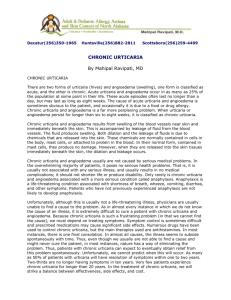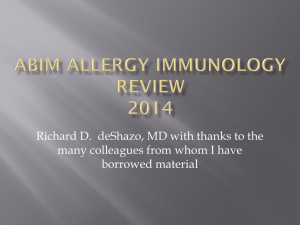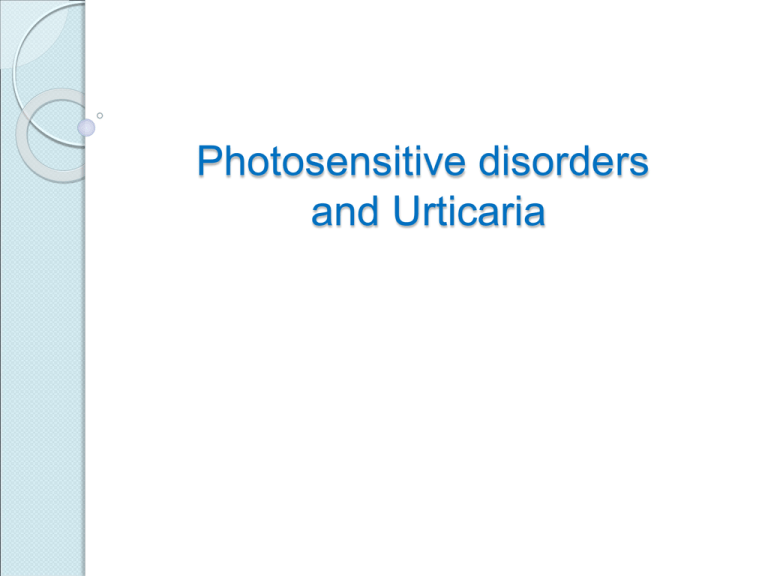
Photosensitive disorders
and Urticaria
Sunlight and Skin
Major source of UV and visible radiation
interacting with human skin.
UV radiation : UVC: 200-290 nm
UVB: 290-320 nm
UVA: 320-400 nm
Visible radiation: 400-760 nm
Infrared radiation:760 -100,000 nm
Normal effects of sun exposure on skin:
Sunburn, Tanning, Photoaging, Vitamin D
synthesis.
Skin Phototypes(Fitz Patrick Classification)
I - always burns, never tans
II - always burns, minimally tans
III - burns moderately, gradually tans
IV - burns minimal, always tans
V - burns rarely , severely tans
VI - deeply pigmented.
Indian skin phototypes: Type IV-VI
Classification of Photosensitive disorders
Genodermatoses
◦ Xeroderma pigmentosum, Bloom’s syndrome,
Cockayne syndrome
Idiopathic
◦ Polymorphic light eruptions, Actinic prurigo,
solar urticaria
Phototoxic and photoallergic reactions
◦ Reactions induced by topical/systemic drugs,
chemicals or contactants
Contd…
Classification of Photosensitive disorders
Metabolic
◦ Porphyria, Pellagra
Tumours
◦ Basal cell ca, Squamous cell ca, Melanoma,
Actinic keratoses.
Diseases aggravated by sun exposure
◦ Lupus Erythematosus, Rosacea,
Dermatomyositis, Acne, Psoriasis, Pemphigus,
Atopic dermatitis, Airborne Contact dermatitis
Polymorphous light eruption (PMLE)
Most common photodermatoses
Idiopathic, probably immunological
Younger age, Females
Recurrent pruritic lesions on photo exposed
areas within minutes to hours after sun
exposure.
Clinical patterns:
◦ Macular, papular,papulovesicles,
plaque,lichen-nitidus like lesions.
Polymorphous light eruption (PMLE)
Differential Diagnosis:
◦ Prurigo
◦ Erythema multiforme
◦ Lichen Simplex chronicus
◦ Atopic dermatitis
Photocontact dermatitis
PHOTOTOXIC
Common
Non immunological
Sunburn
Clinically diagnosed
PHOTOALLERGIC
Less Common
TYPE IV
Hypersensitivity
Eczematous
Photo patch test
Systemic/ topical drugs, chemicals contactants in
combination with UVA spectrum induces
phototoxic and photoallergic reactions.
Phototoxic reactions
Topical:
◦ Perfumes, Dyes, psoralens, tars, plants (lime,
celery)
Systemic:
◦ Psoralen, Tetracycline, Phenothiazine
Photoallergic reactions
Topical:
◦ Perfumes (soaps, aftershave) sunscreens
(PABA)neomycin, halogenated compounds
parthenium (congress grass)
Systemic:
◦ NSAIDS, phenothiazine, thiazides.
Approach to photosensitive disorder
Detailed history :
◦ Age/ Sex
◦ Occupation, Hobbies
◦ Family h/o similar disease
◦ Time interval between exposure & symptoms
◦ Contactant, drug history
◦ Cosmetics, sunscreen usage.
Approach to photosensitive disorder
Clinical diagnosis :
Photoexposed areas:
◦ Face, ‘V’ area& nape of neck, dorsae of hands
& feet, extensors of arms & legs (check
clothing used)
Spared areas:
◦ Under hair fringe, chin, nose, upper eyelids,
behind ears.
Morphological pattern depends on etiology
Investigations
Depending on etiology :
◦ Connective Tissue diseases, Metabolic,
Genetic AnA, dsDNA, porphyrin levels
(blood, urine,stool), Chromosomal
analysis, cell mutation studies, DNA
repair assesment
Biopsy
Photo testing
Photopatch testing
Treatment: Photoprotection
Natural: Ozone, Melanin, Keratin.
Physical: Clothing, broad rimmed hats,
umbrellas.
Topical: Sunscreens, UVA, UVB therapy.
Systemic: Beta carotene, Chloroquin,
Hydroxychloroquin, PUVA
Treatment of causative factor
Removal of offending drug/chemical/contactant
Steroids (topical/systemic)
Immunosuppressives (Azathioprine,
cyclosporin, Thalidomide)
Sunscreens - Topical
Physical
Reflect, scatter light
Zinc oxide
Titanium dioxide
Ferrous oxide
Chemical
Absorbs light &
prevents penetration
through skin
Anthranilates,
benzophenones,
cinnamates, salicylates
Sunscreens - Topical
Broad spectrum - UVA & UVB protective
SPF 15 or higher in Indian skin
Proper application & use in all seasons needed.
Liberal and uniform application to photo exposed
areas, half an hour prior to sun exposure.
1ml – Face
–
Female
1.5ml – Face – Male
Frequent reapplication if involved in vigorous
exercise, swimming.
Sunscreens - Topical
Broad spectrum - UVA & UVB protective
SPF 15 or higher in Indian skin
Proper application & use in all seasons needed.
Liberal and uniform application to photo exposed
areas, half an hour prior to sun exposure.
1ml – Face
–
Female
1.5ml – Face – Male
Frequent reapplication if involved in vigorous
exercise, swimming.
Urticaria
It is a reaction pattern consisting of
erythematous, transient, itchy swellings
(wheals) on the skin
Urticaria is derived from the word “Urtica” (in
Latin = Stinging Nettle)
Pathogenesis
Enhanced vasodilatation + Vaso permeability
Plasma leakage
Wheals
Histamine stimulates nerve endings
Pruritus
Neuro-peptide release
Skin response (flare)
Response to histamine release from cutaneous mast
cells
Often seen with Angioedema
Causes
Exogenous
Endogenous
Physical
Emotional stress
Idiopathic
Contd…
Causes
EXOGENOUS
◦ Inhalants: pollens, house dust, fungi, dander.
◦ Ingestants: Foods: fish, egg, brinjal, food
additives, dyes, preservatives.
◦ Drugs: penicillin, NSAIDs, sulfonamides.
◦ Contactants: beestings, insect bites, plants.
Causes
ENDOGENOUS
◦ Infections:
Gastrointestinal, respiratory, urinary tract
infections
Bacterial, protozoal, helminthic, viral (CMV,
EBV, HSV)
◦ Systemic diseases:
Hashimoto's Thyroiditis
Systemic Lupus Erythematosus
Chronic active hepatitis
Malignancies
Causes
PHYSICAL URTICARIA
Cold Urticaria
◦ Affects hands, ear, nose and lateral thighs
Cholinergic Urticaria
◦ Fever
◦ Hot baths
◦ Exercise-Induced Urticaria
Solar Urticaria (Sun induced)
Pressure
◦ Tight clothing
◦ Soles of foot and other weight bearing points
◦ Dermographism
Types of urticaria by duration:
Acute Urticaria (present hours to weeks)
◦ Idiopathic in 75% of cases
Chronic Urticaria (persistent beyond 6 weeks)
◦ Idiopathic in 95% of cases
◦ May be related to autoantibody to IgE
Clinical features:
Symptoms
◦ Pruritus
Signs
◦ Characteristics
Hives or wheals
Spreads with scratching and coalesce to form
large patch
Course of Lesions
◦ Lesions last 90 minutes to 24 hours
Dermographism
Dermographism is a condition where linear
wheals are elicited by stroking or scratching the
skin
These wheals subside within 30 minutes
Some patients have chronic dermographism
which may persist throughout life
Angioedema
Non-pitting subcutaneous swelling
◦ Well demarcated
◦ Distribution
Face
Hands
Buttocks
Genitalia
Abdomen
Laryngeal angioedema (Anaphylaxis)
Anaphylaxis is a medical emergency
Workup in a patient of Urticaria
Careful History
Travel and work history
Ingestion of foods, medications, herbals,
vitamins
Recent infection
Negative history makes finding cause more
difficult
Known allergies
Family History of allergy or Thyroid disease
Investigations
Consider brief panel depending on history
i. Hb, CBC
ii. Urine analysis
iii. Stool analysis
iv. ESR
v. Liver Function Tests
vi. TSH
vii. ANA
Skin biopsy if lesion present >24 hrs, consider
urticarial vasculitis
Autologous Serum test
Treatment
Management :
General
◦ Rule out Anaphylaxis
◦ Discontinue offending drugs, food, or behavior
◦ Offer Reassurance
Discuss idiopathic nature of chronic urticaria
Unlikely to identify a specific cause
Contd…
Treatment
Step 1: Non-Sedating Antihistamines (e.g.
Fexofenadine)
◦ Less effective antipruritic as compared to
sedating Antihistamine
◦ Consider for daytime urticaria symptom control
Step 2: Sedating Antihistamines (e.g. Hydroxyzine)
◦
Consider for night time and refractory to step 1
◦ Beware of sedation and risk of fall in older
patients
Step 3: Add H2 Receptor Antagonist (e.g. Ranitidine)
Contd…
Treatment
Step 4: Other anti-histaminics
◦ Doxepin
◦ Cyproheptadine
Step 5: Leukotriene modifier
◦ Montelukast
◦ Zafirlukast
Step 6: Systemic Corticosteroids
◦ Prednisone 20-40 mg PO qd
◦ Caution : Process may flare when steroids are
weaned off
Thank you

